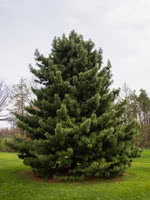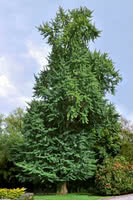Mon-Fri 9am - 5pm Mountain time
Ginkgo Biloba vs Korean Pine
Pinus koraiensis
Ginkgo biloba
NOT AVAILABLE THIS SEASON - MIGHT RETURN
NOT AVAILABLE THIS SEASON - MIGHT RETURN
Korean Pine is an attractive conifer suitable for shelterbelts, privacy screens, and ornamental planting. This tree is especially prized for its pine nuts. Korean Pine nuts are larger than most other species. They can be used in salads, pesto sauce, and other foods.
This conifer is generally tolerant of urban conditions but much prefers cool summer climates.
The Ginkgo Biloba is regarded as one of the most distinctive and beautiful of all the deciduous trees, and has remained genetically unchanged for millions of years. Its beautifully fan-shaped leaves develop a clear yellow colour in fall. Graceful and attractive year-round, Ginkgo is the perfect conversation starter in your yard.
Korean Pine Quick Facts
Ginkgo Biloba Quick Facts
Toxicity: Uncooked nuts in large quantities

